
|

|

Recovering from breast cancer treatment is different for each woman, and depends on the extent of the treatment received.
This is a matter of healing.
After your surgery, however major or minor, you will need time to heal. You may also need to do some physical therapy or stretching exercises to regain your body's "range of motion." Ask your health care provider if this is necessary for you.
Once your treatment is finished, it's important to have regular follow-up exams. Don't forget to visit the Long Term Follow-up section for more information about regular follow-up exams.
Caption: "Wall Walking" is a common range of motion exercise.
If you're thinking about a mastectomy, you may be concerned about how you will look and feel with one breast, and you may wish to consider your breast reconstruction options.
Appearance is very personal, and women have very individual feelings after this surgery. There are three options available for women who have had mastectomies.
Prosthesis:
You can wear a prosthesis, which is a carefully designed false breast, that is worn in a specially made brassiere. There are a variety of shapes and styles to match your other breast and fit you comfortably.
Breast Reconstruction Surgery:
You can have breast reconstruction surgery, in which a plastic surgeon will recreate a breast shape in place of the cancerous breast that was removed. You may choose artificial implants like pouches filled with silicone (a jelly-like material) or saline (salt water); or you may choose to have your own body tissue transferred from elsewhere in your body. Reconstructive surgery can happen at the same time as your cancer surgery, or at a later time.
Living With a Single Breast:
You may also choose to live with a single breast. Some women feel that a prosthesis is uncomfortable, or don't want the additional surgery and recovery time. This is a personal choice, and should depend on how at ease you feel with one breast.
A breast prosthesis is a removable artificial breast form attached to your chest or worn under clothing.
Many women choose a temporary prosthesis before they leave the hospital. Then, they can carefully shop around for a model that more closely resembles their breast at a later time.
Caption: The prosthesis in this picture fits into a pocket in a bra.
Depending on your specific operation and needs, there are a wide variety of prostheses to choose from. Some fit into a pocket in a bra. Others are a breast form designed to be attached securely to your chest using a kind of adhesive glue. You have a choice of weight, color, size, and shape. Some prostheses have attachable nipples.
With most prostheses, you can still wear strapless dresses, lingerie and participate in athletic activities. Several companies also make clothing like lingerie and bathing suits with hidden pockets to hold a prosthesis in place.
Caption: This picture shows many types and shapes of prostheses.
You can also have a prosthesis custom made for you, which is more expensive. A custom-made prosthesis will have a much more precise match to your own breast shape.
Some breast reconstruction looks like a real breast, but not all surgical results look perfect and yours may look real only under a bra or clothing. Unclothed, you will be able to see that you've had breast surgery.
Consultation with a plastic surgeon is generally recommended in order to determine the breast reconstruction options for your particular situation. If possible, you should discuss breast reconstruction before your cancer surgery because the position of the incision can affect the reconstruction. Unfortunately, many women consider the option of reconstruction only after breast surgery.
Reconstructive surgery has made many women feel emotionally and physically more comfortable with themselves and their appearance after breast cancer surgery. Reconstruction is for women who want something more permanent than a prosthesis.
Some women feel that putting on a prosthesis everyday isn't natural, and reminds them of their battle with cancer. Plastic surgery has helped them put their battle with cancer out of their minds Ð for them the additional surgery is "worth it."
Using an Artificial Material
A surgeon uses an artificial substance like a silicone filled implant or a saline filled implant to create a breast form that is placed under your pectoral muscle. You may have a choice of which artificial implant you'd like. Silicone is a gel, and saline is simply a salt water solution.
Using Your Own Tissue
In this method a flap of skin, muscle, and fat is taken from your abdomen (or back, or buttocks). The flap is moved to the opening in your chest and then the tissue is sewn back into place.
When having breast reconstruction with silicone or saline implant, an incision is made in the breast area and the implant is inserted under your chest muscle (the pectoralis), forming a bulge. The skin is then sewn back together. Implants alone usually work well for creating smaller breasts. If you need to have a larger breast, a tissue expander may be used, which is explained later on this page.
There have been some safety concerns with leaking implants in the past, but plastic surgeons assure us that if such a risk does exist, that the chances are very small. The FDA is continuing to study the long-term affects of breast implants. The most common problem occurs when the scar around your implant begins to tighten and squeeze the implant (making it feel harder). This is called capsular contracture. Treatment for this may involve removing or cutting the scar tissue, or perhaps removing or replacing your implant.
An advantage to artificial implants is that the implant surgery is easier to do than the transfer of your own tissue. Implants require much less surgical time than reconstruction using your own tissue, so the usual risks of anesthesia and surgery are lesser as well. Your hospital stay is usually about one to three days.
Silicone Gel Filled Implants
Silicone implants are filled with silicone gel, encased in a rubber-like bag. Since April 1992, they are available only to women having breast reconstruction. The Federal Food and Drug Administration (the FDA) requires that all women who have silicone implants after breast cancer surgery be enrolled in a long-term research study.
Silicone Lined, Saline Filled Implants
These implants are encased in a rubber-like bag, lined with silicone, but filled with saline (salt water). Unlike silicone filled implants, these implants are available for cosmetic surgery (also called breast enlargement) and for reconstruction after breast cancer surgery. They have recently (as of 1995) become more popular than the silicone filled implants.
First, an empty sack is inserted behind your chest muscle and then the incision is sewn shut. Over time (two to six months), your health care provider will inject increasing amounts of saline into the bag through a valve under the skin. This stretches your skin and muscle.
When your new breast area reaches your desired size, the sack is removed and replaced with a permanent artificial implant (silicone or saline filled). The saline expander is not left in permanently because it does not look as natural as a permanent implant.
An advantage to the expander is that you can get a more natural breast appearance or use a larger permanent implant, since you can stretch your skin out to your desired size. A disadvantage is that some women find the muscle and skin stretching uncomfortable. You will also need to visit your health care provider more frequently to have the saline injected.
Caption 1: A tissue expander is inserted following the mastectomy to prepare for reconstruction.
Caption 2: The expander is gradually filled with saline through a valve to stretch the skin and muscle enough to accept an implant.
Caption 3: After surgery, the breast mound is restored. Scars are permanent but will fade over time. A nipple and areola can be reconstructed at a later date.
This new breast may feel more real since it's your own tissue and not an implant, but it will have little sensation at first.
An advantage of this procedure is that you're using your own tissue for your reconstructed breast, not an artificial implant. A disadvantage is that you've taken a muscle from another part of your body (your abdomen, back, buttocks, or thigh) and that part of you will have a surgical scar and possibly some weakness.
This flap surgery (such as the "tram flap" from the abdomen) is a complicated and long surgery, up to 5 to 10 hours. You will usually spend four or five days in the hospital, and the stitches will be removed in two to three weeks. Full recovery may take 4 to 7 weeks.
Caption 1: With flap surgery, tissue is taken from the back and tunneled to the front of the chest wall to support the reconstructed breast.
Caption 2: The transported tissue forms a flap for a breast implant, and it may provide enough bulk to form the breast mound without an implant.
Caption 1: Tissue may be taken from the abdomen and tunneled to the breast or surgically transplanted to form a new breast mound.
Caption 2: After surgery, the breast mound, nipple, and areloa are restored, if desired.
Caption 3: After surgery, the breast mound is restored. Scars are permanent but can fade over time. A nipple and areola can be reconstructed at a later date.
Yes, you should be aware of the risks of implant leakage, infection, capsular contracture caused by internal scarring, and that your implant may not last a lifetime.
If I use the saline expander method, how often do I visit my health care provider for an injection?
Saline expander inflation is done in the physicians office approximately every 2 weeks depending on the progress of the expansion process.
If I use the saline expander method, how long will I have a tissue expander in my body?
Temporary saline expanders are in place usually from 2 to 6 months. It may be necessary to "over expand" Ð or stretch the tissue beyond the size you want in order to achieve a more natural result with the permanent implant.
Does the saline expander hurt?
Discomfort associated with the expansion process varies with each patient and with how rapidly the tissue is expanded. Pain medication and restricted activities may be necessary at each expansion interval in selected patients.
Can I have nipples reconstructed too?
Yes, nipple reconstruction can be done with either implant or tissue transfer reconstruction. Although reconstructed nipples don't have normal sensitivity and function, they do make your reconstructed breast look more natural.
How will my reconstructed breast look?
It will look like a normal breast under clothes, but naked it will be visible that you have had breast surgery.
Isn't plastic surgery expensive? Will my insurance pay for this?
Breast reconstruction is a covered benefit by most insurances, although some policies require partial payment by patients. Some aspects of reconstruction Ð such as reducing or lifting the opposite breast to provide a balanced result Ð may not be covered. Your physician can assist you in checking with your insurance.
What kind of long term problems are there with a reconstructed breast, both implants and flap surgery?
Some risks of silicone implants were noted earlier and many of these apply to saline filled implants, too. Flap surgery can be associated with delayed healing and rarely tissue loss (most common in smokers) as well as the unusual specific problems such as abdominal hernia.
Can I get cancer in my reconstructed breast?
If you've had breast reconstruction, you can get cancer in your own tissue over your implant or over the tissue expander. Having breast reconstruction does not make you immune to cancer in the future. However, it will also not hide recurrences.
Do most women have reconstructed nipples?
Personal choice varies, but most women undergo nipple reconstruction and many women feel it "completes" their result.
How long does it take for surgical scars to begin to fade?
All scars are red, raised, and firm at first but most mature over 6 to 12 months. If prominent scars persist, scar revision may be an option.
What happens if my transfer tissue does not survive?
Whenever tissue is transferred from one part of the body to another, there is a risk of tissue loss. Approximately 95% of all tissue transfers will survive, but if the tissue is lost, an alternative reconstruction method may be considered, such as a different tissue transfer or an implant.
I was one-sided, you know. But then the nurse told me to get some old stockings and put in my bra and that would make my breast, make me, you know, look even and everything. And I did that for a while. Then a lady gave me a prosthesis and it was larger than my breast, so that I still looked uneven and was lop-sided. So finally, I got one, but welfare wouldn't pay for it. I had to scrape some money and get it myself. And I got one. Then you had, you know, you're supposed to wear the bras that hold the prosthesis. So being the ingenious me, I got a girl that had one. I looked at hers and I took and traced the paper over it and I went home and I cut me out some, and I sewed them inside of my regular bras and that's what I've worn ever since.
Before my surgery I went to see a plastic surgeon in town. We talked about reconstruction. I went by my intuition. There was not quite the silicone scare that there is now. But my thinking at the time was that my body was going to be going through so much with chemotherapy and surgery that I did not want to put my body through one more thing at that time. If I wanted it later on, I could have it later on. I just did not want to put anything foreign in my body. So I had a prosthesis. It fits into your bra, so you have a pouch in your bra that it fits into. But when you lean forward, it would lean with you so that it would go away from your skin, which I found to be uncomfortable. You have to be careful what clothes you wear. It's a little bit distressing finding clothes that are still a little bit feminine but not real low cut. So I went through that process for a while, and then about a year and a-half ago, they came out with a new prosthesis and now I have one. I have a piece of velcro that is on my skin and then I attach the prosthesis right to it, so it's attached to my body. They say you can sleep in it. I don't just so that it will last longer. It's made it a lot easier for clothes and just feeling good about myself. I mean, I don't think about it now like I did before, which is what you want to do. When you are diagnosed with cancer, that's all you think about. Of course, it is, because it's so scary.
.
My little nephew, he was vacationing down in Florida, and Shawn said I want to go home to be with my Auntie. She's had cancer and they rode all the way on a motorcycle from Florida way up to Sault Ste. Marie. He's only about eight. He was really curious about Grandma's boob. He's a very friendly little guy, so he had a lot of little friends his age. So I was bending over and my boob fell out and their eyes got about this big. What's happening to Grandma? She's falling apart. The next day they called up some of their friends and they were all giving me a hug. They were playing a game to find out what side was the boob and what side wasn't the real thing. And all the laughs they gave me was just really therapeutic.
I asked my husband and he said "I don't care how many breasts you have, two, or three, or one." I said "Okay, fine then. I just won't do it." Because, I mean, just for looks you cannot tell what's prosthesis, right? I think another thing is the philosophy between east and west. The west society you can see all the advertisements, the girls wear swimming suits, you know. You have to have this sex appeal. The Orientals think different. Really, the function of breasts is to nurse the baby, so it didn't bother me at all. I think it might bother some American women.
Looking back on it now, I think I would probably choose to have breast reconstruction done. I still have my prosthesis. Its just an inconvenience. I'm not particularly bashful about walking around my house without a bra in a T-shirt. So I'm a little lopsided. It does make a difference in the way that your clothes fit, and I like to play tennis and wearing a prosthesis inside a bra and it jumps around and it just gets to be a little bit uncomfortable. But I think it does affect you and that sensual, sexual aspect of yourself. That's something that I would certainly ask anyone to consider before they actually go in for surgery. And sometimes we don't know what we want. I didn't think I was going to miss my breast at all, but I really do.
He offered it to me on two separate occasions, and I turned it down both times. I am innately suspicious of putting anything in my body and I was not interested in, it just seemed like a bad idea to me. And I'm not sorry. I think I made the right decision.
I got to the point where I wouldn't even look at myself anymore, but it wasn't where I'd had the mastectomy. And this to me is funny because I had read so many books where the ladies would say, all right, I've decided today is the day where I'm going to look at my scar. And I thought, oh, cripe, I lifted the bandage up right away and looked and I thought, well, I've always been big busted. This is kind of nice. This is a cool feeling. As long as I have to do this, this is nice and cool for the summer. The part that bothered me was to see the one breast there. It wasn't the one that was missing, it was the one that was sort of just like hanging there all by itself, so lonesome. I decided that, gee, if this should happen again, maybe they'll consider taking the other one off. And if they had, maybe I wouldn't have gotten reconstruction, because that first summer it was very warm. I had a prosthesis. Any time above 70 degrees, I just couldn't throw that think far enough away. It was too hot, too heavy. I didn't mind going without it. I would wear bigger tops.
I had breast reconstruction done and I had it done using my own tissue. What they do is they take the tissue from the abdominal area and they transfer it up here and they create a new breast. And it's very extensive surgery. It's miraculous, and I'm really pleased. There might have been a possibility that could have been done at the time that I had the mastectomy. And it's not always easy to work out the complexities of the surgeon who is doing the mastectomy versus the plastic surgeon who is doing the reconstruction, but these things can be worked out and it is another option. You know, I went through it four years later and it was a twelve hour surgery, but the results of phenomenal. So it's good to know that if you lose your breast, you don't have to be without a breast forever. That they are doing things today with your own tissue that, you know, will give you back a breast and make you feel like a whole person again.
 up to Contents of this Page
up to Contents of this Page
If you've had minor surgery like the removal of a lump, you will need less recovery time than if you've had a mastectomy. up to Contents of this Page
up to Contents of this Page
These are three basic options available for women who have had mastectomies: up to Contents of this Page
up to Contents of this Page
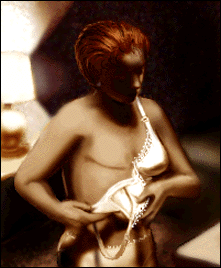
 up to Contents of this Page
up to Contents of this Page
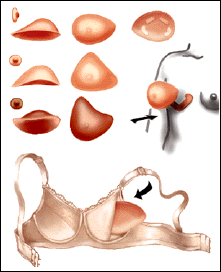
 up to Contents of this Page
up to Contents of this Page
Breast prostheses can be bought from medical supply stores, catalogs and specialty lingerie stores. Check with your health insurance company to see if and how your prosthesis is covered. Different companies have different policies. up to Contents of this Page
up to Contents of this Page
Breast reconstruction surgery creates an artificial breast. Today, almost any woman who has had a mastectomy can have her breast reconstructed. Successful breast reconstruction can occur even if you have radiation-damaged, thin, or tight skin. up to Contents of this Page
up to Contents of this Page
It is also important to realize the limits of breast reconstruction, and what cannot be achieved by plastic surgery. If you decide to have reconstruction, what your plastic surgeon creates is not a real breast. It is a breast form attached under your skin and will never have the sensation that your original breast did. Your artificial breast may feel normal to touch by others, but the sensation of being touched will never feel completely the same to you. up to Contents of this Page
up to Contents of this Page
There are two basic methods for reconstruction surgery. The main difference is whether you use an artificial material (like silicone or saline) for your implant, or use your own tissue, taken from elsewhere in your body, to re-create a breast form. up to Contents of this Page
up to Contents of this Page
If you choose an artificial implant instead of using your own tissue, you may select from two types of filling materials - silicone or saline. Your plastic surgeon can answer questions you may have about implants and help you determine what may be best for you. up to Contents of this Page
up to Contents of this Page
A different method of putting in an artificial implant involves the use of a saline tissue expander to stretch out the chest wall skin and muscle before placing the implant. up to Contents of this Page
up to Contents of this Page
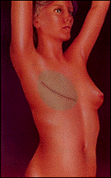
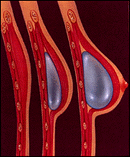

 up to Contents of this Page
up to Contents of this Page
You can also reconstruct a breast form using your own tissue. In this method, a flap of skin, fat or some muscle is taken from either your abdomen (belly), back, buttocks, or thigh. The flap of tissue is moved to your chest area, where you had the mastectomy, and it forms a new breast. All incisions are sewn closed, and blood supply to this tissue either remains attached or is reconstructed during surgery. A nipple and areola can be reconstructed at a later time. up to Contents of this Page
up to Contents of this Page
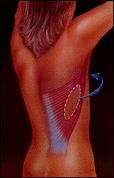
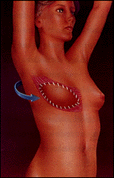
 up to Contents of this Page
up to Contents of this Page
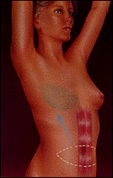

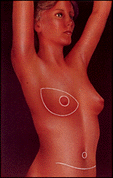
 up to Contents of this Page
up to Contents of this Page
Aren't there risks with silicone implants? up to Contents of this Page
up to Contents of this Page
![]() Bernadine's experience
Bernadine's experience
![]() Carole's experience
Carole's experience
![]() Geneva's experience
Geneva's experience
![]() Lily's experience
Lily's experience up to Contents of this Page
up to Contents of this Page
![]() Angelita's experience
Angelita's experience
![]() Sheila's experience
Sheila's experience
![]() Colleen's experience
Colleen's experience
![]() Maggie's experience
Maggie's experience
 back a breast and make you feel like a whole person again.
back a breast and make you feel like a whole person again.
